Pickling involves soaking foods in acid or brine, preventing harmful bacteria from growing. It is straightforward (though some foods have a high learning curve).
Picking your own food is also very cheap since you don’t need any special equipment. You can even use recycled jars.
Why Learn to Pickle Foods?
- Healthy bacteria: Lactofermenting creates healthy probiotic bacteria, which are very good for your gut health. Researchers now attribute these probiotics (or the lack of them!) to conditions including autism, asthma, obesity, mental health, and more.
- Preserve food: Americans throw away a huge amount – upwards of 40% of food we buy ends up in the trash. If you can’t eat food in time, pickle it to preserve it.
- Emergency food: Do you have a 2-week emergency food stockpile (as the Red Cross and FEMA recommend)? While you shouldn’t rely on pickled foods alone in emergencies, they can be a good part of your food stockpile.
- Tastes good: Pickling gives foods a tangy taste. It can make some bland foods taste much more exciting.
How to Pickle Foods
There are two ways of pickling foods: vinegar pickling and lacto-fermentation. The processes and results are very different.
Vinegar Pickling
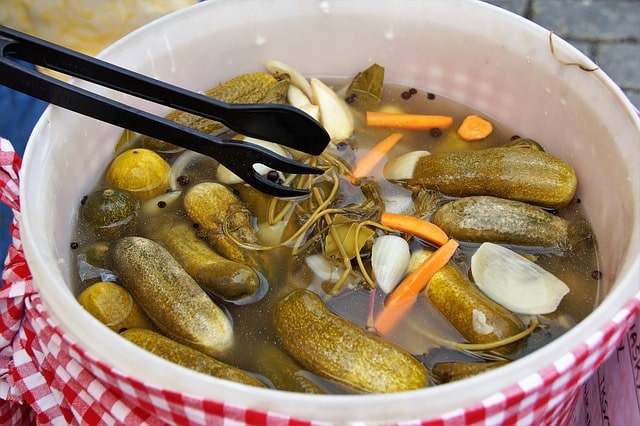
The first method of pickling involves vinegar. You soak the food in vinegar with at least a 5% acidity. Some methods call for you to boil the food in the vinegar solution.
There is a lot of controversy about whether these “quick pickles” need to be refrigerated. So long as the lid stays on, the vinegar should preserve the food for several weeks – even out of the fridge.
However, there is a risk of contamination when the vinegar pickles are left out of the fridge. Thus, to make the pickles last for a very long time, they should be canned after pickling. When canned, the pickles can last 5+ years.
Read this post on home canning instructions for more.
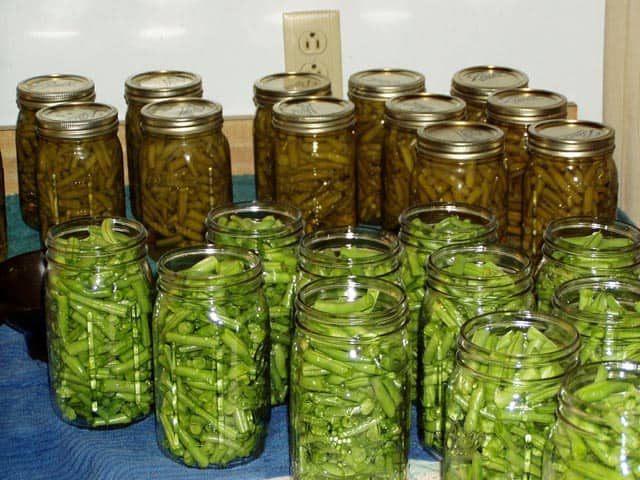
Lacto-Fermentation Pickling
This method of pickling is very popular now, mainly because it creates gut-healthy bacteria. It involves submersing food in a brine of salt and water. The salt draws natural sugars out of the food.
Lacto bacteria, naturally found on the surface of food, eat these sugars and produce lactic acid.
The acidic, oxygen-less environment prevents harmful bacteria from growing. So long as the food stays under the brine, it will be protected by the healthy Lacto bacteria.
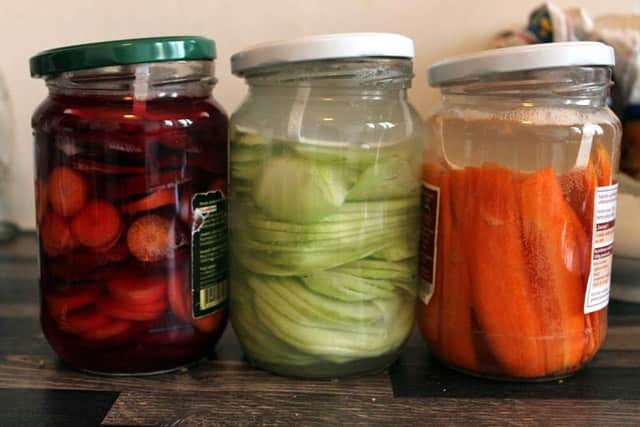
Lacto-fermentation is as simple as these steps:
- Put fresh produce in a clean jar or fermenting crock. You don’t need to sterilize the jars.
- Make a brine: Use about 1tsp to 1tbsp of salt for a quart-sized jar.
- Fill the jar: Leave about 1 inch of headroom in the jar.
- Put a weight on the food so it stays submerged in the brine.
- Loosely cover the jars.
- Allow the food to ferment at room temperature. Fruits ferment in about 24 hours. Veggies usually ferment within 2-7 days. The longer they ferment, the sourer they will be.
- You will see bubbles forming. This is a sign that fermentation is occurring.
- Test the pickles: If it isn’t sour enough for your taste, then leave it to ferment more.
- Put a lid on the jar and move it to the fridge
Getting the Food to Stay Under the Brine
The trickiest part of fermenting (at least for me) was getting the food to stay under the brine. Some people recommend boiling a rock to use a weight.
Another popular recommendation is to use a cabbage leaf, which you press on the pickles. The cabbage leaf also needs to stay under the brine.
I still ended up with food floating to the top of the brine with these methods. Better methods are:
- Baggie filled with water: Fill a sandwich bag with brine water and put this on top of the food.
- Pickling weights – cheap: You can buy special pickling weights. I found super-cheap plastic inserts for the jars, which worked very well for whole pieces of food. They don’t work for shredded foods since the pieces will float up.
- Pickling weights – more expensive: Or you can buy these more substantial glass weights from Amazon
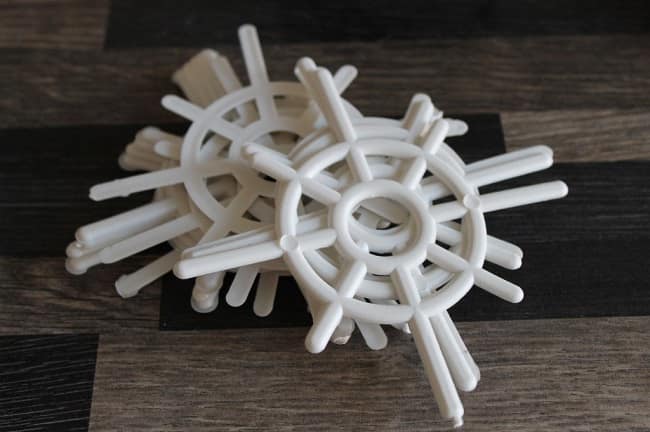
Shelf Life of Lacto-Fermented Foods
When the food is fermented to your taste, put a lid on it and move to a cool, dark place (like a fridge or root cellar). The cool temperature will slow down fermentation.
So long as the temperature stays below 65F, fermented vegetables should last around 4-18 months. Fruit ferments only last about 1-2 months.
To get your pickles to last longer, they must be canned. This involves pouring the brine into a pan, boiling it for about 5 minutes, and then putting the food and brine into canning jars. The jars can then be processed with a water bath canner or pressure canner.
Unfortunately, the canning process will kill the healthy bacteria in natural ferments. However, that’s the tradeoff for food that lasts 5 years.
Exploding Jars
The bacteria responsible for fermentation produce gas as a byproduct. If you seal the jar tightly during fermentation, the gas can build up and cause it to explode. You only need to loosely cover the jars while fermenting to prevent this. Some people cover them with cheesecloth or coffee filters.
After a few days of fermenting, the amount of sugar available for the bacteria to eat will be lower. This will slow down fermentation. Cold temperatures will also slow fermentation, which is another reason to move ferments to a cool location after they are fermented to your liking.
However, the bacteria can continue to ferment even in a refrigerator. Over time, the gases will build up, and you might end up with an exploding jar. There are a few ways you can prevent this from occurring:
- Occasionally, “burp” your jars by removing the lid to let gas out.
- Use special airlock lids. These lids have vents that allow air to escape.
- Make sure you leave enough headroom in the jar. Thick, creamy foods (such as kefir) need lots of room because air bubbles can get trapped inside the food.
Notes
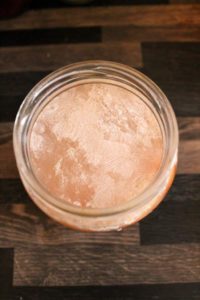
- Iodized Salt: Iodine in salt slows down fermentation. Ideally, you use iodine-free salt. I’ve had success with iodized salt, though.
- Starters: There is no need to buy a starter. The food will ferment with just table salt.
- White film: You might see a white film on top of your ferments. This is okay – scrape it off.
- Brown or black film: This is a sign that your fermented foods have gone bad. You will need to throw the entire batch away.
- Garlic: It will turn blue when fermented. It is still edible but looks weird.
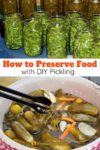


Hi great site cant wait to start can you let me know what the little white plastic weights are called. I cant find them on amazon, as i wish to make anf give away i dont want to buy the more expensive ones. Thank you.
Best regards Vickie
I got mine in a rural store. I haven’t seen the exact same ones anywhere else. But there are ones Amazon called “pickling pushers” which look even better than the ones I have.
Hi Diane from Portugal –
I am also looking for cheap plastic weights to push down my pickled onions, pepperdews etc and I cannot find these anywhere – I am despairing. Everything is ripening now – what rural store did you buy from – I am desperate enough to ask them to post to me.
In Serbian and Croatian, these are called “Pritiskivač” or “Pritiskivač za turšiju”. If you search, you can probably find a store which ships internationally. You’ll probably have better luck with a Croatian store because of the EU.
But you could probably make these out of some flexible (food safe) plastic. For example, my 1kg peanut butter containers have large plastic lids. You could cut the plastic lid into a star-like shape to fit your jars.